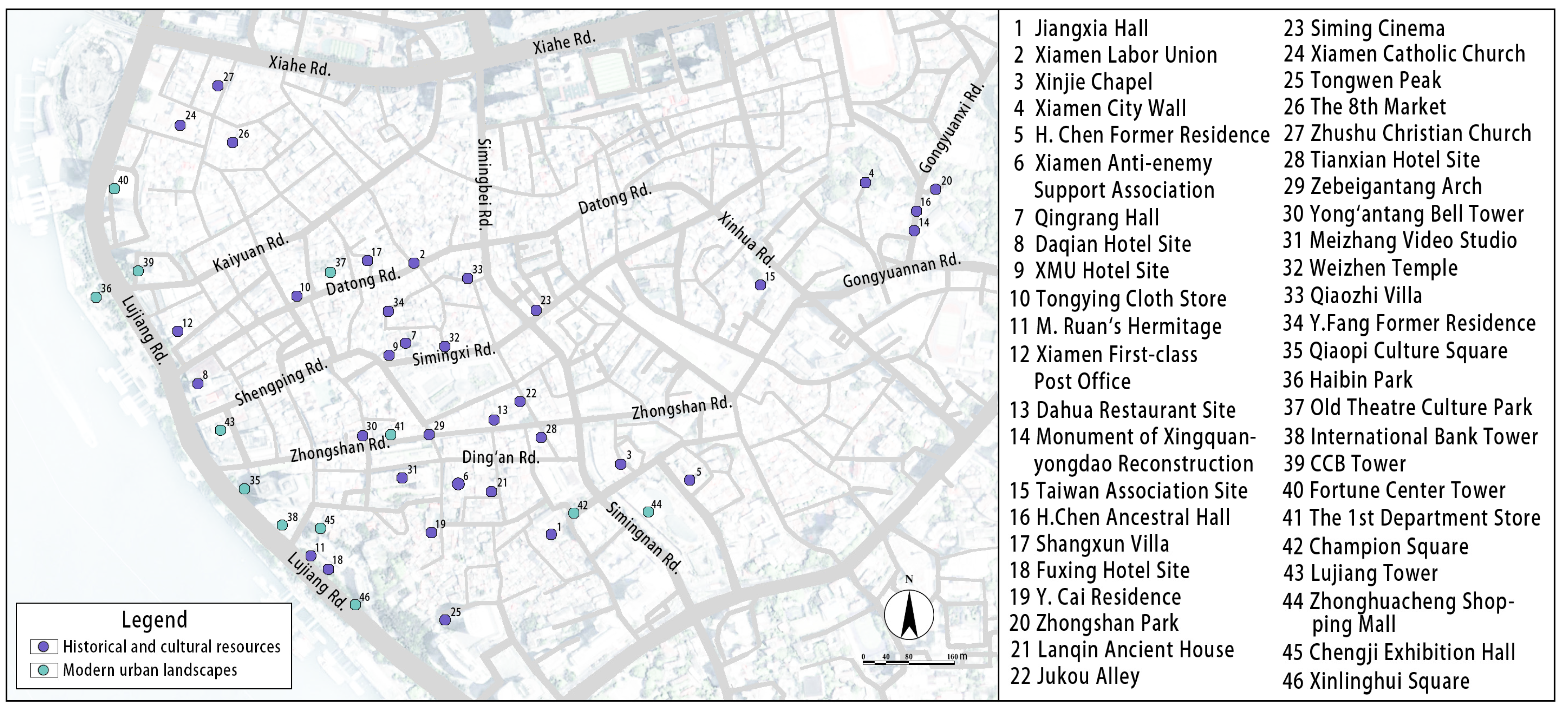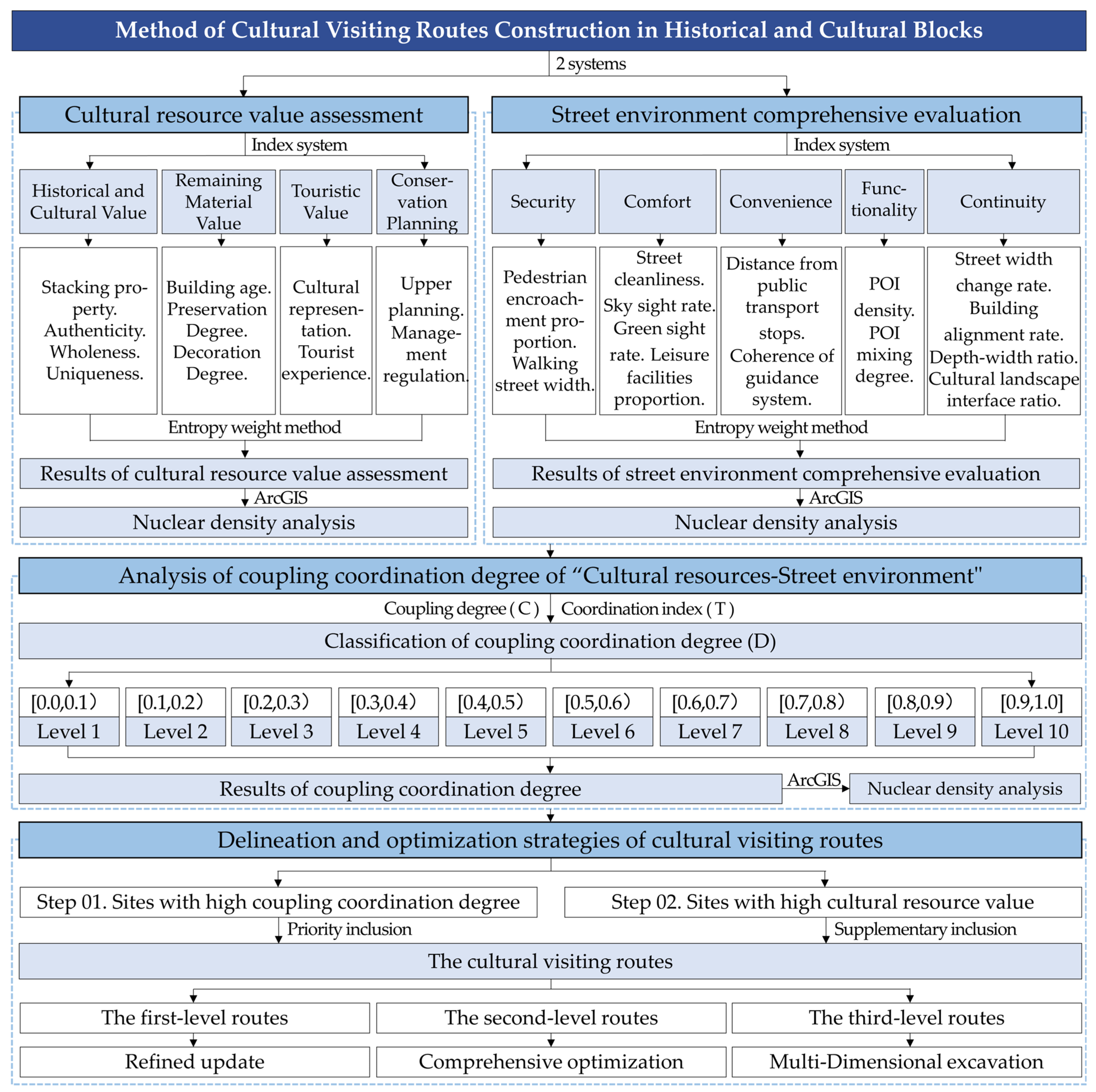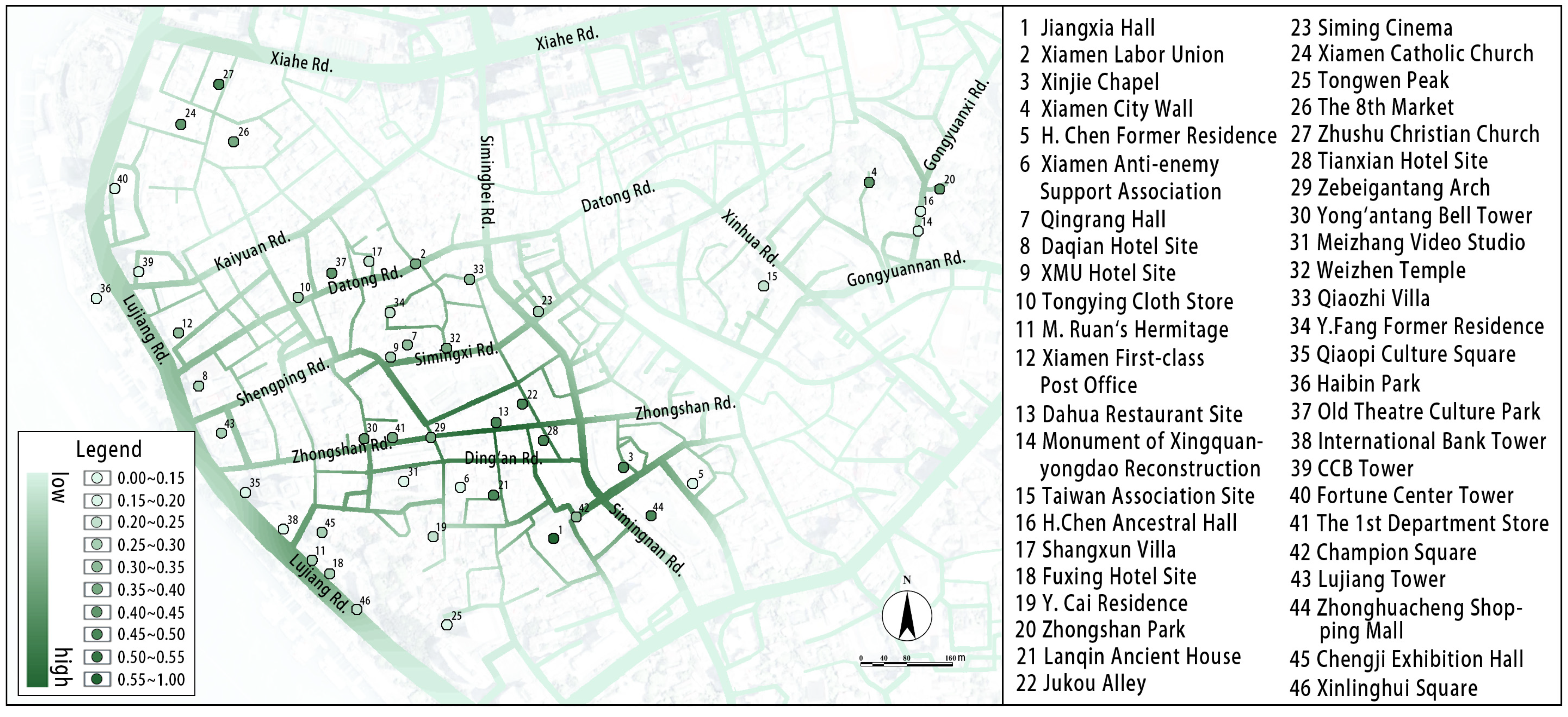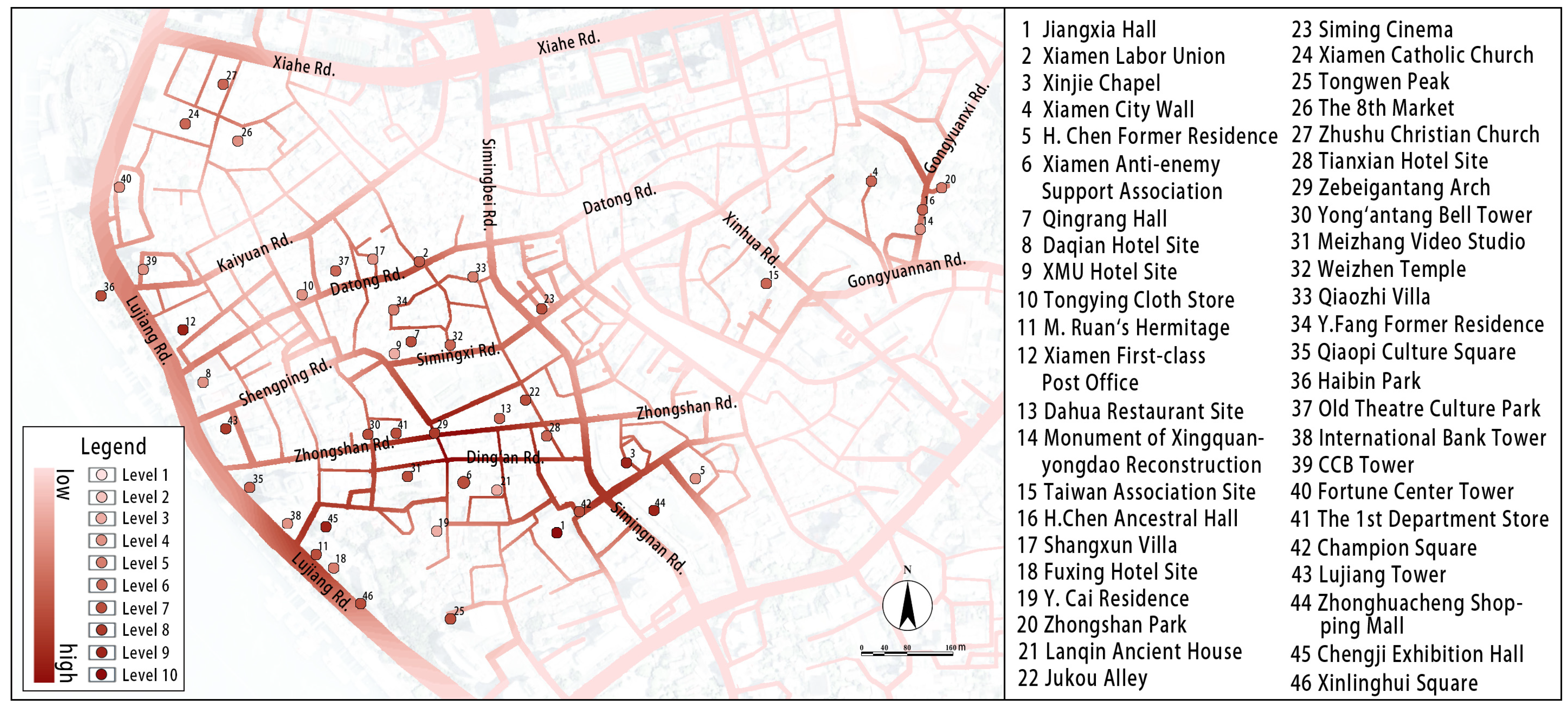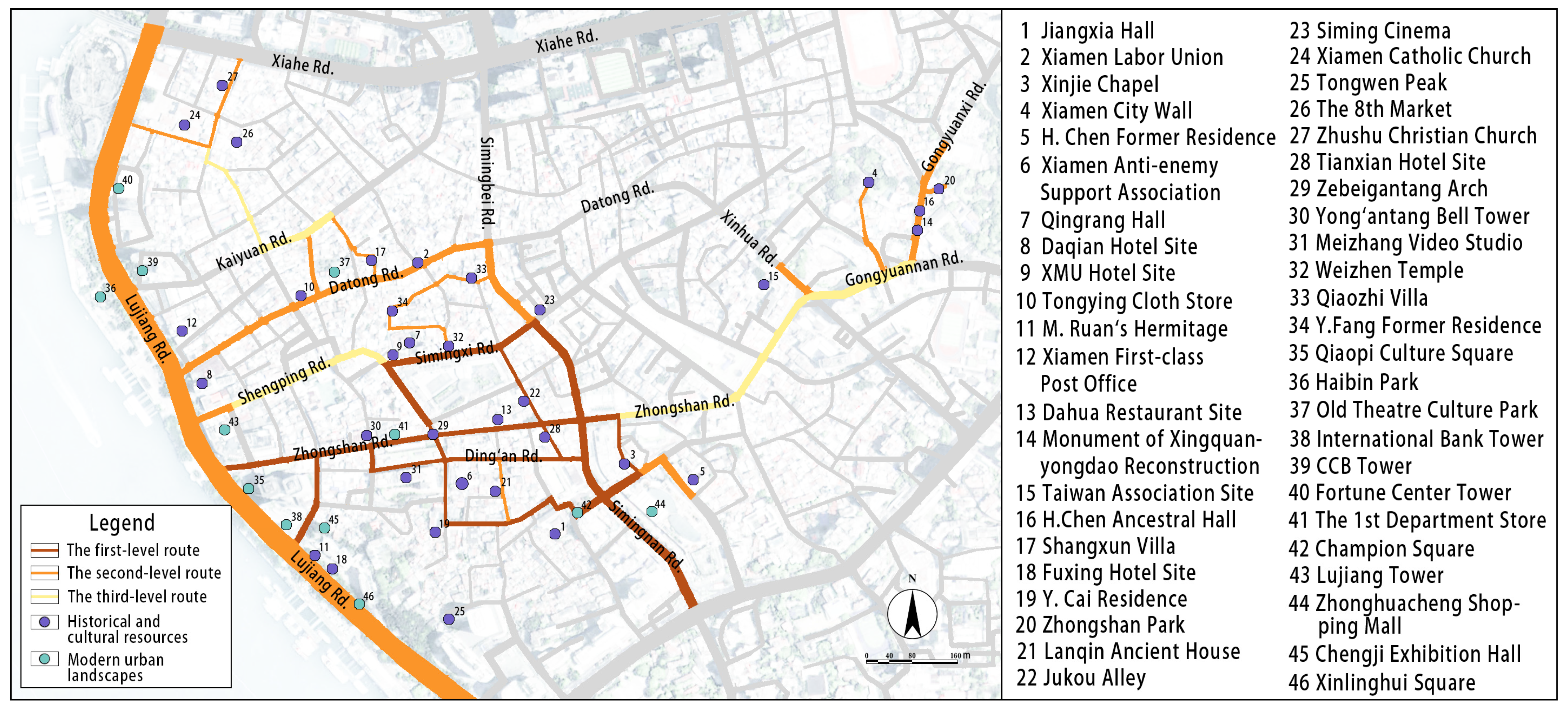1. Introduction
The historical and cultural block serves as a crucial medium for shaping the city’s image [
1] and currently represents a significant area for heritage conservation research and practice. Numerous “dot-shaped” visiting resources exist within the historical and cultural block. However, surveys indicate that public visitation behavior is generally confined to a limited number of well-known attractions. As a result, tourist visits tend to be scattered, fragmented, and isolated, hindering visitors from developing a systematic and comprehensive understanding of the block [
2]. Furthermore, this “dot-shaped” visiting behavior leads to the underutilization of the historical and cultural resources within the block, adversely affecting both the protection and utilization of these cultural assets and the overall development of the historical block. Consequently, a pressing concern in the protection and development of historical and cultural blocks is how to foster a holistic understanding and relevant visitation patterns among visitors.
In recent years, China has witnessed a notable increase in city walking activities. According to the 2023 National Tourism Satisfaction Survey Report of China, city walking ranked first among various tourism modes, demonstrating a clear advantage with a proportion of 82%. This trend presents a potential opportunity for the development of cultural visiting routes. Cultural visiting routes serve as a form of urban experiential tourism, utilizing streets as linear spatial carriers to connect scattered cultural relics, monuments, cultural facilities, modern urban scenic spots, and other cultural resources in an organized manner. These routes address the needs of both sightseeing and urban experiences, highlighting the city’s significant landscapes and cultural characteristics [
3,
4]. They emphasize the systematic continuity of the cultural spatial pattern [
5] and offer a novel approach to integrating dispersed cultural resources.
Cultural visiting routes can be categorized into regional and urban types based on spatial scales. Regional cultural routes are often closely associated with linear cultural heritages, such as the Grand Canal [
6], the Great Wall [
7,
8], and the ancient Tea Horse Road [
9,
10]. Their primary aim is the comprehensive protection and cooperative development of the region. In contrast, urban cultural routes consist of network structures that connect historical and modern cultural resources within the city [
5,
11]. These routes emphasize the preservation of cultural resource value and their effective integration with tourism. Notable examples of such practices can be observed in major international metropolises, including Paris, Tokyo, and Seoul. Specifically, urban cultural routes can be categorized into three types based on visitation characteristics [
3]: (1) Path-type visiting routes, which connect various cultural sites through specific lines, effectively guiding visitors’ route selection in an intuitive manner. A notable example is the 4 + 4 visit routes in Seoul. (2) Region-type visiting routes, which are based on the principle of value priority, rate various resources in the region with star ratings and encourage visitors to choose their own routes based on the star level map. For instance, Paris is divided into 12 visiting areas. (3) Theme-type visiting routes, which are always centered around a particular story or type of culture, often featuring distinctive thematic elements, such as London’s Ghost Story Tour. This study posits that path-type cultural visiting routes are the most suitable for historical urban areas where resources are concentrated yet require development. Furthermore, these routes can be extended to historical and cultural blocks. As the overall walking environment in the region improves, subsequent stages may consider enhancing the integration of cultural resources within historical and cultural blocks through the development of region-type and theme-type visiting routes.
Previous studies indicate that cultural resources are pivotal in shaping a city’s local identity and enhancing the resilience of historic districts [
4,
12]. The protection and effective utilization of these resources in historic and cultural districts can successfully preserve the historical continuity and cultural diversity of a city [
13]. In exploring cultural resources, establishing a suitable value assessment model can provide significant support [
14,
15]. The integration of cultural resources with the tourism industry is advantageous for the sustainable development of historical blocks [
16]. Furthermore, a conducive pedestrian environment is essential to ensure the accessibility of cultural resources [
17,
18]. A pedestrian-friendly environment can attract both tourists and investment, which can foster the preservation of cultural resources and the growth of the tourism sector [
17]. Consequently, a well-connected, walkable, and accessible pedestrian environment is as vital as the cultural resources themselves [
19,
20,
21]. As early as the last century, new urbanism and landscape urbanism proposed an urban design framework that emphasizes density, walkability, and mixed-use development [
22,
23], viewing cities as semi-network structures composed of various nodes and linear elements [
24,
25]. This framework established a model language based on location, network, and process for subsequent studies on walkability [
26]. Currently, research on walkability encompasses the analysis of factors influencing the pedestrian environment [
27], the evaluation of street environment suitability [
28,
29,
30,
31,
32,
33], the design of walkability [
34], and the application of big data and machine learning [
35,
36], etc. In designing the pedestrian system, the integration of cultural resources is crucial [
12]. It is evident that cultural resources and the pedestrian environment mutually reinforce each other, collectively contributing to the sustainable development of cultural exploration routes.
Overall, previous studies have focused on the construction methods of cultural visiting routes at both regional and urban scales. However, the scientific delineation of cultural visiting routes at the block scale, along with targeted optimization methods for the visiting environment, has not received adequate attention. In the field of research methods, qualitative analysis that emphasizes the significance of cultural resources continues to be the predominant approach for constructing regional cultural visiting routes [
37]. However, in the context of developing urban cultural visiting routes, there is a growing trend towards the integration of quantitative methods, including resource value assessment and walking environment evaluation [
5]. According to existing studies, the assessment of cultural resource value and the evaluation of the street walking environment are the key systems that influence the development of cultural visiting routes. However, most studies have primarily focused on the evaluation and optimization of individual systems, with limited discussion on the interrelationship between these two systems.
The coupling coordination degree model, a widely employed method for investigating the cooperative development relationships among multiple systems [
38,
39,
40], can be utilized to analyze the interplay between cultural resource value and the street walking environment while also exploring their comprehensive benefits. This model has been extensively applied across various multidisciplinary fields following long-term development, particularly in the study of two or more related systems. Currently, relevant research primarily focuses on the domains of economics, ecology, and management. Therefore, for the coupling coordination degree model to be effectively applied in urban contexts, it is essential to enhance and redefine the model in accordance with the unique characteristics of the discipline and specific research issues. This refinement must ensure that the calculation elements within the model accurately represent each subsystem of the research topic, thereby facilitating a comprehensive analysis of the development of each subsystem and their overall benefits.
Therefore, this study focuses on the block scale, using the Zhongshan Road Historical and Cultural Block in Xiamen City, Fujian Province, China, as a case study. By disassembling the key constituent elements of cultural visiting routes at this scale, the paper constructed evaluation index systems for both cultural resource value and the street walking environment. Utilizing the existing coupling coordination degree model and integrating the characteristics of cultural visiting routes, we proposed an original application method of the coupling coordination degree specifically tailored for these routes. This study investigated a method for constructing cultural exploration routes based on objective data by analyzing the coupling and coordination relationship between two key aspects. The main research steps include the follow: (1) identifying valuable cultural resources within historical and cultural blocks through material collection and site surveys and developing an indicator system to assess the value of each point; (2) conducting an evaluation of the surrounding street walking environment for each cultural resource site through field investigations and public questionnaires; (3) applying the coupling coordination degree model to analyze the relationship between “cultural resource value” and “street walking environment” at each point; and (4) delineating cultural visiting routes and proposing targeted enhancement strategies based on the results of the coupling coordination degree analysis. The study aims to optimize the method for constructing cultural visiting routes at the block scale and presents specific strategies for implementation.
2. Study Area
Xiamen City is situated on the southeast coast of China, along the western bank of the Taiwan Strait. It encompasses the mainland area of Fujian Province adjacent to Xiamen Bay, as well as Xiamen Island, Gulangyu Island, and several other islands, as well as Xiamen Bay. This study focused on the historical and cultural block of Zhongshan Road, located on Xiamen Island. In 2020, Xiamen was designated as a historical and cultural city within Fujian Province. The Zhongshan Road Historical and Cultural Block is one of three areas identified in the “Protection Plan of Xiamen Historical and Cultural City (2020–2035)” and covers an area of 125.3 hectares.This block not only serves as a concentration of the historical and cultural resources of Xiamen’s old city but also represents a significant business district that reflects the modern urban style of Xiamen. Rich in maritime trade and southern Fujian culture, the distribution of cultural resources within the block is both fragmented and scattered, underscoring the necessity and typical nature of constructing cultural visiting routes.
First, the study examined cultural resources through profile consultation and field investigation, encompassing four provincial-level cultural relic protection units, 12 municipal-level cultural relic protection units, three Taiwan-related cultural relic protection units, and several historical style buildings, resulting in a total of 34 historical and cultural resources. Second, 12 modern urban landscapes were selected based on Ctrip’s data of visitor engagement (
https://you.ctrip.com/; accessed on 16 December 2023). In total, 46 cultural resources within the Zhongshan Road Historical and Cultural Block were identified (
Figure 1).
5. Conclusions
Historical and cultural blocks have emerged as focal points in heritage conservation due to their dense cultural resources and distinctive appeal to visitors. Cultural visiting routes effectively integrate the protection of these resources with the public’s urban experience, offering a novel approach to the overall preservation and rational utilization of historical and cultural blocks. Existing studies have provided valuable insights into the construction of cultural visiting routes at both regional and city scales, focusing on two primary systems: cultural resource value and the street walking environment. However, the methods employed for constructing block-scale routes remain predominantly qualitative. Therefore, there is an urgent need to explore more scientific methods and optimization strategies for the construction of cultural visiting routes in historical and cultural districts.
This paper examined the Zhongshan Road Historical and Cultural Block in Xiamen, China. It constructed the evaluation index systems for cultural resource value and the street walking environment through literature analysis and public interviews. This study employed ArcMap 10.8 to perform nuclear density analysis based on these evaluation results. Following the coupling coordination results, this study delineated the preliminary cultural visiting routes, which are subsequently refined according to the findings on cultural resource value. After integrating all proposed routes, a cohesive set of cultural visiting routes for the Zhongshan Road Historical and Cultural Block was established. Finally, the paper proposed targeted optimization strategies for varying levels of cultural visiting routes. This study revealed that cultural resource value and the street walking environment are key factors influencing cultural visiting routes, warranting attention and improvement in planning processes. The construction method for cultural visiting routes, based on the degree of coupling coordination, can serve as a valuable reference for implementing these routes on a block scale.
This paper presents the following distinctions compared to other cultural routes research efforts: (1) The study adopts a specific block-scale perspective rather than a broader regional or city scale, detailing the methods and steps involved in route construction. (2) Unlike other similar studies, this paper shifts focus from examining a single system, such as cultural resource value or the street walking environment, to analyzing the coupling and coordination between these systems. This approach can leverage the combined benefits of the two systems as a foundation for route construction. (3) The research introduces the coupled coordination degree model, which has traditionally been utilized in physics, into the realm of urban culture. It proposes a revised and redefined model that is applicable to cultural visiting routes, thereby offering a valuable reference for the application of this model in urban cultural preservation efforts.
While this study offers valuable insights, it also presents certain limitations that create opportunities for future research. The study primarily relies on static data to evaluate cultural resource value and the street walking environment, which overlook potential changes over time. As a result, it can only present the outcomes of route construction for a specific period. Future research should consider integrating real-time data collection with big data platforms to explore methodologies for constructing cultural visit routes based on dynamic assessments and simulations. Additionally, this paper proposes a method for applying the coupling coordination degree model to the construction of block-scale cultural visiting routes. Further research is warranted to promote the application and modification of this model across different scales and regions. Moreover, the adaptation of the coupling coordination model in this paper primarily relies on the redefinition of each term within the formula. Future research can be enhanced through more innovative alterations to this model. Finally, the strategy section of this study predominantly focuses on planning strategies. Future research should not only emphasize the exploration of cultural resource value and the optimization of the street walking environment but also delve deeper into aspects such as management and operation, as well as public participation.
